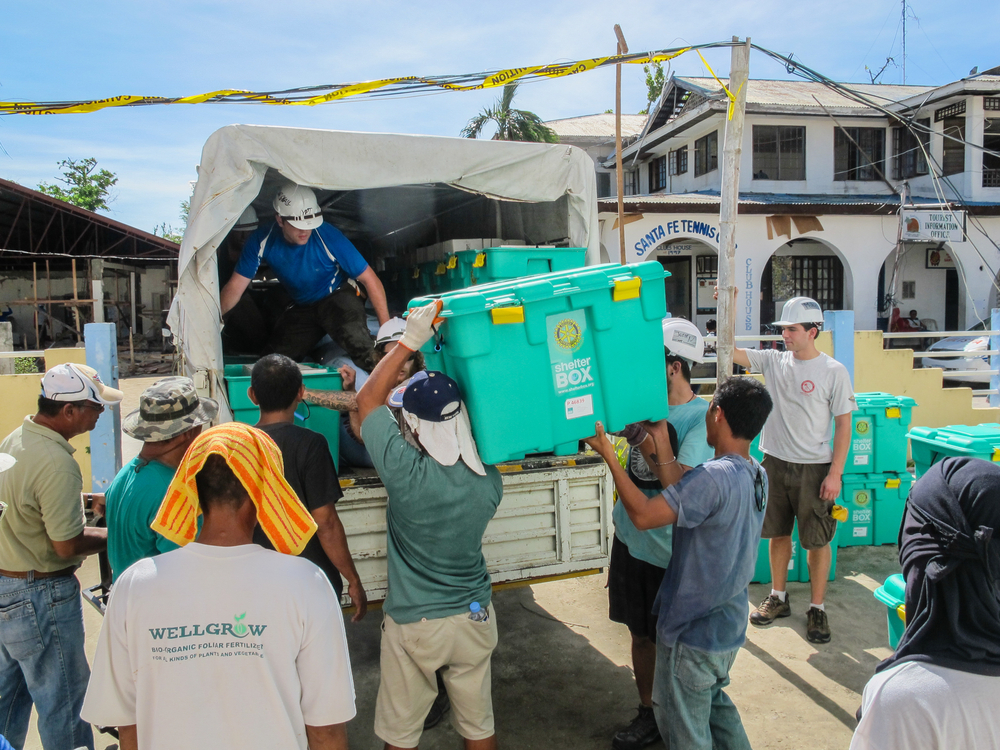THE ART OF EFFECTIVE HUMANITARIAN LOGISTICS
Jim Lanning is currently the Executive Director of Global Benefits Group Foundation. Previously, he served as Director of Acquisitions and Logistics at humanitarian implementers ADRA and IRD. Here, Mr. Lanning illustrates the unintended consequences of overseas donations and discusses the evolution, and future, of the field of humanitarian logistics.
I wish people would understand how complex the process is and how costly it can be, both in terms of time and money. As an example, after a flood, an earthquake, or typhoon, you have this massive outpouring of desire on people’s part to help in some way. That often leads to schools, churches, or organizations doing drives of clothing or other items. These donated goods are complicated to handle in terms of acceptability or usability; whether they’re really needed; difficult to inventory in a manner that’s acceptable for customs; and extremely costly to ship. Then, there are the logistics on the other end of it: receiving it, clearing it, and doing distribution, accountability, and transparency so that the items don’t end up on the black market.
It’s a very complex art, if you will, that not many people really think through. They have this impulse to “clean out the closet and give the stuff to those poor people.” In fact, these well-meaning, well-intentioned donations often just clog up the system, become a burden, and can create unintended consequences that really need to be considered.
“I wish people would understand how complex the process is and how costly it can be, both in terms of time and money… Well-meaning, well-intentioned donations often just clog up the system and become a burden and can create unintended consequences that really need to be considered.”
Right after I started working at ADRA, there was an earthquake in India. Our Rotary Club got together, raised about $60,000, and we were going to send a container of blankets to the survivors of this earthquake. When I called the representative at the ADRA office in India about how to ship the blankets, the phone got really quiet on the other end. He said, “You stupid Americans.” It just took me back: “What do you mean?” And he said, “We’ve been making tents and blankets here for 2,000 years. If these poor people were lucky enough to survive this earthquake, you’re going to put them out of business by flooding the market with free blankets and tents. That’s the stupidest thing you could ever do.”
Point taken! The end of the story is that we ended up sending the money, and they bought the blankets there. They already had the distribution mechanisms in place; plus, there was no shipping cost, clearing cost, or bribes to put up with in customs. It was a much more practical way to handle it. You had an added bonus of actually supporting the economy of the people that you’re trying to help. It benefitted those people greatly to have their economy stimulated and help them recover economically from that disaster.
“We’re trying to help in a global world now, across languages, cultures, and backgrounds—so you need to work very carefully based on a sensitive regional understanding and cultural awareness. ”
As another example, there are parts of Africa that have been flooded with donated clothing. But there are places I have visited where you’ll see piles of clothing being burned. Locals burn the donated clothes because they are convinced that these are clothing from dead people, and that if you wear them, you are going to catch evil spirits. Donating is not as easy as cleaning out the closet. We’re trying to help in a global world now, across languages, cultures, and backgrounds—so you need to work very carefully based on a sensitive regional understanding and cultural awareness.
Experiences like these keep underscoring the desirability, and the practicality, of donating cash and procuring items locally for distribution. I think people are very willing to change their approach, and I believe it’s a matter of awareness and knowledge. Once people become aware of this—just like I became aware—it makes perfect sense. I’ve worked with TOMS, Bobs, Crocs, and all the folks you’ve heard about that are involved in shoe distribution. At one point, one of the big companies came to me and told me that they were interested in participating in an overseas shoe distribution in a certain village. I made the point that, in this village and in this region, shoemaking is a big part of the local economy. They asked what they can do to help. I said, let’s look at it: the local person that makes the shoes spends 90 cents making the pair of shoes, and sells it for a dollar, so they’re making 10 cents profit. If you flood the market with free shoes, you’re hurting them.

A Syrian family receives a one-off unconditional cash transfer. Source: Raber Aziz/IOM 2016
“Experiences like these keep underscoring the desirability, and the practicality, of donating cash and procuring those items locally for distribution.”
nstead, if you go to that local infrastructure, go to the shoe people in that market, make them part of your distribution network, and offer them 10 or 11 cents a pair for doing distribution to orphanages, schools, and to the very poor parts that wouldn’t be your clients anyway—now instead of hurting that market, or even theoretically hurting that market, you’re enhancing the profitability of that little business. All the emphasis in the NGO world on micro-enterprise and economic development models show that you’re better off looking at the whole picture, collectively. Now, in the case of TOMS, they’re taking it a step further by setting up manufacturing plants in Haiti and other countries. By putting people to work in that region, making the shoes that they’re going to be giving away, they’re creating employment opportunities and making a major impact on the economic development of the region they’re trying to help.
I’ve always come from a belief that success should be measured by the beneficiaries that your efforts help. Your measurement should be the number of shoes on a kid’s feet or the number of people that you’ve dewormed of intestinal parasites. It should not be monetary. The websites of big NGOs almost always say “we gave a hundred million dollars worth of this or that”—it’s always about the money. In my mind, we need to keep moving as fast as we can away from measurements in dollars, toward measurements in the numbers of people that you’ve helped, and make your accomplishments and success directly linked to people helped, not dollars.
“Through partnerships, you get a greater benefit, your impact is more measurable, and you’ve got greater accountability and transparency.”
In teams I’ve led, I’ve always measured success by the number of people that we’ve helped, and I try to improve that model by working with other local NGOs; by partnering; by using civic organizations such as Rotary Clubs and churches; and trying to get as many people involved as possible. Through partnerships, you get a greater benefit, your impact is more measurable, and you’ve got more eyes on the programs so you’ve got greater accountability and transparency and less likelihood of things you’re donating ending up for sale on a black market. All of those issues are part of your success, and your success is enhanced when you expand your base of operations to be more inclusive, rather than doing it all through your own agency.
Advancing partnerships can be challenging. Some people want to make humanitarian work an “us and them” thing, especially when trying to do fundraising and marketing. But it’s not as effective, and the tide is shifting: now, your donor base is going to want you to be more efficient. If you can bring two or three organizations together, each with varying strengths, it’s much more efficient. In recent years, those of us in the humanitarian sector were doing more work as a consortium, partnering both with international and local organizations, than we were doing things unilaterally. Ultimately, the big organization provides the infrastructure and mechanisms and the ways to do humanitarian response, but the beneficiaries are never going to know who helped them, and shouldn’t have to know. That’s who everybody in this field is ultimately working for.
Technology has also come a long way and humanitarian response logistics have been enhanced by technological advancements, especially when it comes to tracking, accountability, and monitoring. In the old days, you’d send a container, and you’d hear months later whether or not it got there. Now, you can track containers online in real-time. In the old days, you might have one NGO sending a bunch of blankets, another one sending tents, another sending tarps. A lot of it was random and hit-and-miss. Now, we’re starting to see platforms, networks, and exchanges develop so that you can see what’s going into regions so you don’t flood the market. With technology, there’s much more ability to see who’s doing what so you can respond based on your strengths. Rather than having two blankets for every person and no tent, you’re able to get a broader, more appropriate response in place.
“People are starting to become aware of the importance, significance, and practicality of cash-based donations in humanitarian response.”
In the future, I think there’s going to be much more emphasis on local procurement than on the old model of shipping of containers from other countries. I don’t see the old model completely disappearing—there is a legitimate place for excess usable goods, especially new, to be utilized in the humanitarian sector rather than ending up in landfills—but it’s going to be much more thoughtfully and philosophically done going forward. I see technology platforms being developed so that there’s more coordination in efforts going forward. Philosophically, I see much more acceptance and openness to working together and collaboration. I also foresee more expansion of financial help versus gifts-in-kind (GIK)—not to eliminate GIKs entirely, but I do see that model shifting. People are starting to become aware of the importance, significance, and practicality of cash-based donations in humanitarian response.
Banner image source: Chris Warham / shutterstock.com
Read on Medium




Got something to say?